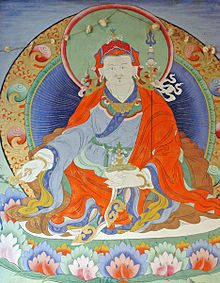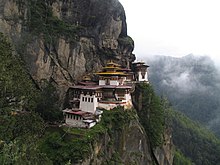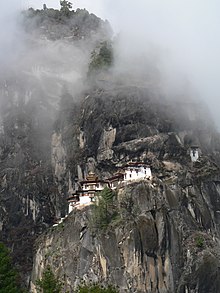Clock slope
Coordinates: 27 ° 29 ′ 30 ″ N , 89 ° 21 ′ 48 ″ E
Taktshang ( Dzongkha : སྤ་ ཕྲོ་ སྟག་ ཚང་ spa phro stag tshang or སྤ་ གྲོ་ སྟག་ ཚང་ spa gro stag tshang ) also Taktsang written or Tiger's Nest is a Buddhist monastery in Paro valley in the Kingdom of Bhutan . The word Taktshang is Tibetan and literally means “Tiger's hideout”. It is located at an altitude of 3,120 meters in the Himalayas and can only be reached by walking for several hours or by mule . The monastery complex is an often depicted cultural landmark of the Kingdom of Bhutan
The monastery complex was inaugurated in 1692, it includes the Taktsang Senge Samdup Cave, in which Guru Padmasambhava is said to have meditated for three years, three months, three weeks, three days and three hours in the 8th century. Padmasambhava, who is also called the Guru with the eight names and who bears the honorary title Rinpoche , brought Buddhism to Bhutan. The monastery is dedicated to him.
history
Legends
There are several legends about Taktshang, which also explain the unusual name "Tiger's Nest". It is believed that Guru Padmasambhava fled there on the back of a tiger and that he tamed the tiger.

Another, similar legend is about Yeshe Tsogyal, a former empress who became a disciple of Guru Padmasambhava. She turned into a tiger and carried Padmasambhava from Tibet to the Taktshang Caves. There the Guru meditated and completed the eighth incarnation . Since then, the site has been considered sacred and has been named "Tiger's Nest".
Another legend is about Tenzin Rabgye, the builder of the monastery in 1692. It is said that Guru Padmasambhava was reborn in the form of Tenzin Rabgye and that he performed various miracles.
Development into a meditation site
The Taktshang Caves have become a popular place for religious Buddhist practices after the death of Guru Padmasambhava. Several Tibetan high priests came there, such as B. Milarepa (1040-1123), Pha Dampa Sangye (? -1117), Machig Labdrön (1055-1145) and Thangton Gyelpo (1385-1464). From the 12th century many Lama priests moved from Tibet to Bhutan to build monasteries there.
Construction of the monastery
In the 17th century the priest Tertön Pema Lingpa of Bumthang founded several monasteries in Bhutan. He is also considered to be the originator of various religious and secular dances that are still performed today in the Paro Valley at the annual Tshechu Festival. During the same period, Ngawang Namgyal , who was persecuted for religious reasons in Tibet, fled to Bhutan. He organized the public administration in the country and thus gained political influence. He is regarded as the founder of Bhutan and received the honorary title "Shabdrung". From 1644 to 1646, Tibet waged a war against Bhutan. Shabdrung made a pilgrimage to Taktshang and requested the assistance of Padmasambhava in fighting the invaders. Eventually Bhutan won the war. Out of gratitude, Shabdrung decided to build a monastery at the Taktshang Caves. However, he did not live to see the completion. The wish to build the monastery was fulfilled by his successor, the 4th Druk Desi Tenzin Rabgye (1638–96). He consecrated the monastery during the Tshechu festival in 1692 and dedicated it to Guru Rinpoche Padmasambhava.
Fire in 1998
In the past there were repeated fires in the monastery, mostly the butter lamps being the cause. Most recently, on April 19, 1998, a major fire broke out in the main building of the monastery. A monk was killed in the process. The building contained valuable paintings and other rare items that were severely damaged. It is believed that an electrical short circuit was the cause. The government of Bhutan and the royal family financed the restoration of the buildings and facilities. The work was completed in 2005.
Environment and access
The monastery is located about 10 km north of the city of Paro on a steep rock face about 900 m above the valley floor. The buildings stand directly on the almost vertical rock ledges. Pieces of cloud often envelop the mountain wall and create a mystical atmosphere. The monastery can only be reached on foot, hiking boots are recommended and you should be as free from vertigo as possible. You can also cover most of the way by mule or horse.
There are about 800 meters of altitude to be overcome and around 3 hours of walking time must be allowed for the ascent. There is a prayer wheel driven by a water wheel along the way. It is said that the water is blessed through contact with the mill. Later you reach the Urgyan Tsemo monastery, which is also built on a rocky promontory. There is a cafeteria here, where you can take a break and enjoy the view of the Taktshang monastery. The mules cannot go any further from here, so the rest of the way can only be done on foot. This section of the route is considered to be particularly scenic. Pine trees, a large waterfall, prayer flags and many small places of prayer line the path. Finally you get to the main building of the monastery.
Visitors need a guide, they can visit the monastery every day from 8:00 a.m., provided the guide has obtained permission in advance. The monastery closes at 5:00 p.m. in autumn / winter and at 6:00 p.m. in spring / summer. Safety rules must be observed at the entrance. Photography in the monastery complex is not permitted. You should inform yourself in good time about the currently valid regulations.
The monastery complex
The monastery complex consists of four main temples and several residential buildings that lean closely against the rock walls. Four of the eight caves are open to visitors. Butter lamps illuminate the interior. The cave in which Padmasambhava lived and meditated is called "Pel Phuk" and is usually closed to visitors. The buildings are connected to one another by wooden bridges and by narrow paths or stairs carved out of the rock. Each building has a balcony from where you can enjoy the view of the valley. There is an image of Buddha in the tallest building. Many rooms are decorated with paintings depicting religious scenes. Also noteworthy are the prayer wheels, which are driven by hand by the monks.
See also
Individual evidence
- ^ A b c John A. Ardussi: Gyalse Tenzin Rabgye and the Founding of Taktsang Lhakhang . (pdf) In: Center for Bhutan Studies (Ed.): Journal of Bhutan Studies . 1, No. 1, Thimphu, 1999, p. 28. Retrieved August 11, 2018.
- ↑ Teresa Rodriguez Williamson: Fly Solo: The 50 Best Places on Earth for a Girl to Travel Alone ( EN ). Perigee, 2007, ISBN 0-399-53310-9 , p. 170 (accessed August 11, 2018).
- ↑ a b Skip Yowell: The Hippie Guide to Climbing the Corporate Ladder and Other Mountains: How ... ( EN ). Thomas Nelson, 2007, ISBN 1-59555-852-7 , pp. 155–156 (accessed August 11, 2018).
- ↑ a b c Pommaret, Francoise: Bhutan Himalayan Mountains Kingdom (5th edition) . Odyssey Books and Guides, 2006, pp. 136-7.
- ↑ The Paro Tsechu ( EN ) Retrieved on 14 August 2018th
- ^ The Paro Tsechu - the Thondrol of Guru Rincpoche ( EN ) Retrieved August 14, 2018.
- ↑ Brown Lindsay et al. a .: Bhutan . Lonely Planet, 2007, ISBN 1-74059-529-7 , pp. 129–130 (accessed August 14, 2018).
- ↑ a b c d Tiger's Nest Monastery . In: SKR Reisen . Retrieved August 15, 2018.
- ↑ In The Kingdom Of Bhutan ( EN ) Global Sapiens. October 6, 2002. Retrieved August 14, 2018.
- ↑ lywa: The Benefits of Prayer Wheels ( EN ) April 2, 2015. Accessed August 15, 2018.




